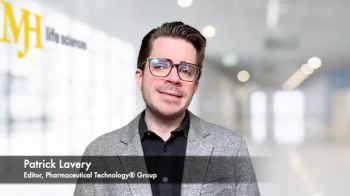
- Pharmaceutical Technology-02-02-2020
- Volume 44
- Issue 2
Managing Risk for Cell and Gene Therapy Logistics
Vein-to-vein programs are focusing on data access and traceability.
The past few years have seen dramatic growth in cell and gene therapy research and commercialization. As questions of access and cost continue to come up, developers are adding new capacity to help keep up with explosive demand for new therapies. Over the past few months, Kite Pharma and Novartis have both built new facilities in the United States and Europe, while Lonza, WuXi Biologics, and other contract development and manufacturing organizations (CDMOs) have been expanding manufacturing capacity.
Established ways of gathering, transferring, and storing data and materials for traditional biopharmaceuticals will not work in the evolving supply chain for autologous and allogeneic therapies. For one thing, manufacturing and transport involve many more diverse stakeholders and patient groups than traditional programs, while, for autologous therapies, there is a need to closely coordinate raw material extraction and final product production, and transport to and from collection centers and from manufacturing to clinic.
Over the past six months, alliances have started up to streamline data management and access to improve the transmission of data from raw material collection points to manufacturing, and to patients at the point of use. In one such collaboration, the CDMO Lonza, IT company Vineti, and logistics specialist Cryoport are working to optimize logistics for cell and gene therapies.
Lonza’s formal collaboration with Vineti had begun in July 2019, to integrate the CDMO’s MES and electronic batch record (EBR) execution solution with Vineti’s supply chain orchestration platform, designed to connect manufacturers and healthcare providers at point of care, in real time.
Vineti, which focuses on supply chain management for cell and gene therapies, has been in business for approximately four years, and grew out of GE Ventures, says cofounder and CEO Amy DuRoss. Back around 2012, a leading biopharmaceutical company with a chimeric antigen receptor T cell (CAR-T) product in Phase III had approached GE to help with unprecedented manufacturing and supply-chain issues. The product, which is now commercially available, was being produced almost entirely manually, says DuRoss, and presented the most complex supply chain and logistics workflow requirements ever seen in the history of biologics. “They were using brute force against the production and delivery of each therapeutic. Once they saw that they were likely to commercialize, they realized that there was no way to scale production and delivery on a manual basis,” she says.
For roughly two years, GE Ventures evaluated the challenges involved, and Vineti was set up in 2015 as an independent company to automate those specific supply chain and logistic workflow requirements. The company uses an enterprise platform developed inhouse, and an integration layer driven by application programming interfaces (APIs).
Simplifying data integration
With CDMOs, the connection point depends on what the partner wishes to emphasize. With Lonza, for example, the emphasis is on the MES and EBR system. “Vineti is managing chain of identity and chain of custody externally, and providing data as a feed internally into Lonza’s shop floor,” DuRoss says.
The two partners plan a number of other integration efforts that will deepen the capacity for data sharing and integration to improve capacity optimization. “CDMO customers no longer have to handle data integration themselves, since the system will already be built for them to link into,” she says. Cryoport’s Chief Commercial Officer Mark Sawicki discussed its work in cell and gene therapy logistics and supply chain management with Lonza and Vineti with Pharmaceutical Technology.
Tackling challenges
PharmTech: What is one of the most challenging aspects of working in cell- and gene-therapy logistics today?
Sawicki: The supply chain is far more complex than it is for monoclonal antibodies or small molecules. Regenerative medicines are patient-specific materials. You cannot simply order bulk materials and manufacture lots of product and just push those out to market. In addition, there is a lot of variability in procuring the materials (i.e., you’re typically dealing with severely immunocompromised patients, so scheduling to get them in to pull materials, to transport or manufacture them, can be an issue). In some cases, patients can get sick or there can be weather issues.
As a result, scheduling is extremely challenging, especially for autologous materials. It is a bit easier for allogenics, but, at this point, networks for transporting donor materials have not yet been fully vetted.
Complicating the picture is the fact that the manufacturing processes associated with autologous therapies are not mature. This means that developers often have to extend instrumentation and processes that have been used for single-patient production to large-scale manufacturing in a commercial manufacturing environment. The interconnectivity and optimization of workflow isn’t there yet. Companies such as Lonza are trying to identify automation competencies to make the process move faster and more smoothly, but, as an industry, we aren’t there yet.
Finally, the manufactured materials themselves are extremely fragile and irreplaceable, but they have to be pushed back out under very rigorous timelines and exacting conditions. You don’t have the latitude for deviations because they might destroy the product or even kill the patient. All of these elements create significant complexity that the industry hasn’t had to deal with before.
Data management and IT systems
PharmTech: What do these challenges mean for CDMO and sponsor data management and IT systems?
Sawicki: IT is a huge consideration. We are now working to integrate our individual IT systems so that information flows from one system to the next. The goal is to eliminate the need for manual intervention and reduce the risk of human error. At Cryoport, we have also begun to use artificial intelligence (AI)-based tools to examine product workflow, the risk elements associated with moving material in, manufacturing, and moving product back out. The only way that these AI systems can be effective is by gaining access to large amounts of data, and we’re now able to pull that data through our partnerships.
A potential role for AI
PharmTech: What is required for interconnectivity, and did you develop the AI systems in-house or with a partner?
Sawicki: Systems must be nimble enough to talk to each other, so that if there is a delay during one phase of the process (e.g., during transportation, manufacturing, or administration) the information can be pushed out through the entire system so that everyone understands the ramifications of what is going on.
We hired our own data scientists to develop the AI systems, although Vinetti is working on AI systems of its own. Our use of AI is focusing on all around risk management for materials, and how we can use existing data more effectively to manage risk and improve operations, whether for storage or distribution. By the third quarter of next year, we expect to roll out a new version of our software that will include several of the AI features that we’re working on now.
PharmTech: How do you connect to CDMOs and to the clinical side? What elements are needed?
Sawicki: We typically connect through electronic data interchange or APIs using either a pull or push, bidirectional, or unidirectional process from conduits that have been designed to transition or share data with clients’ enterprise resource planning systems and portals, as well as Vineti’s IT platform. In some cases, elements of our IT system are being replicated inside a partner’s site.
If a Lonza client, for example, wants to schedule distribution of an autologous product, they can go into Lonza’s system, find an interface to our system, and get whatever help they need. Solutions providers such as Vineti are designing systems that are as flexible as possible to enable data to flow more easily between systems.
Specialized containers and cleaning validation
PharmTech: What led Cryoport to develop the customized containers?
Sawicki: The advanced therapy shipper line is a segregated, specially engineered fleet to support the distribution of clinical and commercial cell and gene products. We rolled it out to get ahead of what we anticipate future FDA regulations to look like, and to focus on what we expect to become most important feature of any shipment and packaging product in this space: traceability.
Currently, two third-party foundations, the Foundation for the Accreditation of Cell Therapies and the Standards Coordinating Body for the Alliance for Regenerative Medicine, are putting together recommendations for FDA in conjunction with ISO [International Organization for Standardization] TC 276, which will establish a long-term regulatory framework for the cell and gene space.
Our goal is to use the same standards that you would see in a GMP manufacturing environment for the equipment that is used to transport these materials to end users. Some standards are data related (e.g., for data loggers, track and trace, and geo-fencing), but the most important aspect is establishing traceability for equipment performance.
We can verify and confirm the historical utilization of every piece of equipment, who used it, and where and for what. That’s one of the most important elements that is being introduced in the program.
We’re also introducing a validated cleaning process for the industry that demonstrates a 99.9999% reduction in all contaminants, which brings it as close to product sterilization as possible (since it would be physically impossible to sterilize shippers and tanks out in the field). This will eliminate the risk of cross-contamination.
Standards and outcomes research
PharmTech: What are you expecting in terms of standards (e.g., for good distribution practices for the new therapies)? Are there existing standards, and what are you expecting FDA and the European Medicines Agency to do?
Sawicki: Existing standards are based around International Safe Transit Association (ISTA) protocols that have been used for the past 30 years. One liability is that these protocols incorporate a tolerance for deviation that is fine for small molecules or many biologics but could potentially render regenerative medicines unuseable.
With many cell and gene therapies, deviations from prescribed environmental conditions, even those that last for a few milliseconds, half a second, or a second, can destroy product completely. There is no visible way to tell whether the cells are still useable after an upset. You won’t be able to tell if the viability of the cells has gone from 90% to 10% without doing extensive testing.
This is why full traceability is so important, so that you know how a given piece of packaging will perform each time it leaves or returns to the manufacturing facility. Traceability looks at the risk of cross contamination, at equipment performance, and at the traceability of each shipment and whether it has been subjected to any shocks or condition deviations.
These data will eventually be connected to outcomes research. Say, for example, a sample has been shipped at the correct temperature, but affected by shear events along the way. It will eventually be possible to determine whether these incidents had any impact on product efficacy. If a client has dosed 13,000 patients during this time period, they would be able to examine the data and see any patterns that come up. We maintain every bit of data generated by our systems and can currently go back nine years and provide regulators with any information they request.
Services bottleneck
PharmTech: Is there currently a bottleneck in the services available for cell and gene therapy development?
Sawicki: As more products come to market, there are issues with scale. Some producers haven’t had the bandwidth to keep up with demand, and this has held back their growth. Then there is the issue of viral vector manufacturing capacity and the risk of having a single supplier for the required materials.
Currently, many of the materials required for GMP manufacturing of cell and gene therapies are single sourced, which is extremely risky, and manufacturers are typically smaller providers because this is a niche industry. The 800-pound gorillas aren’t yet supplying reagents and other necessities because there was no market for them five years ago. However, today there is still a pipeline of 1000 clinical products, all of which use GMP starting materials from single, small provider sources. That poses a major risk.
Scaleability issues
PharmTech: How about scaleability?
Sawicki: This is easier to manage for autologous treatments. As you move to allogeneic products, instead of 2000 or 3000, you will be dealing with two or three million, and fleets will move from 1000 to 100,000. There’s only so much existing capacity for liquid nitrogen shippers. This is also true for storage and distribution. For example, how will pharmacies do the visual inspection required when releasing allogeneic product from a liquid nitrogen tank when performing visual inspection can potentially render product unuseable? The industry must resolve many of these questions.
Article Details
Pharmaceutical Technology
Vol. 44, No. 2
February 2020
Pages: 48-50
Citation
When referring to this article, please cite it as A. Shanley, "Managing Risk for Cell and Gene Therapies," Pharmaceutical Technology 44 (2) 2020â¨.
Articles in this issue
almost 6 years ago
Pre-Clinical: Laying the Right Foundationalmost 6 years ago
Global Supply Issues Create Challengesalmost 6 years ago
The Call for a Rapid Responsealmost 6 years ago
ICH to Revise Quality Risk Management Guidelinealmost 6 years ago
Brexit: What Happens Next for Pharma?almost 6 years ago
Of Serious Concern?almost 6 years ago
Best Practices in Using Isolator Technologyalmost 6 years ago
Data Management Practicesalmost 6 years ago
Blister Packaging MachineNewsletter
Get the essential updates shaping the future of pharma manufacturing and compliance—subscribe today to Pharmaceutical Technology and never miss a breakthrough.





